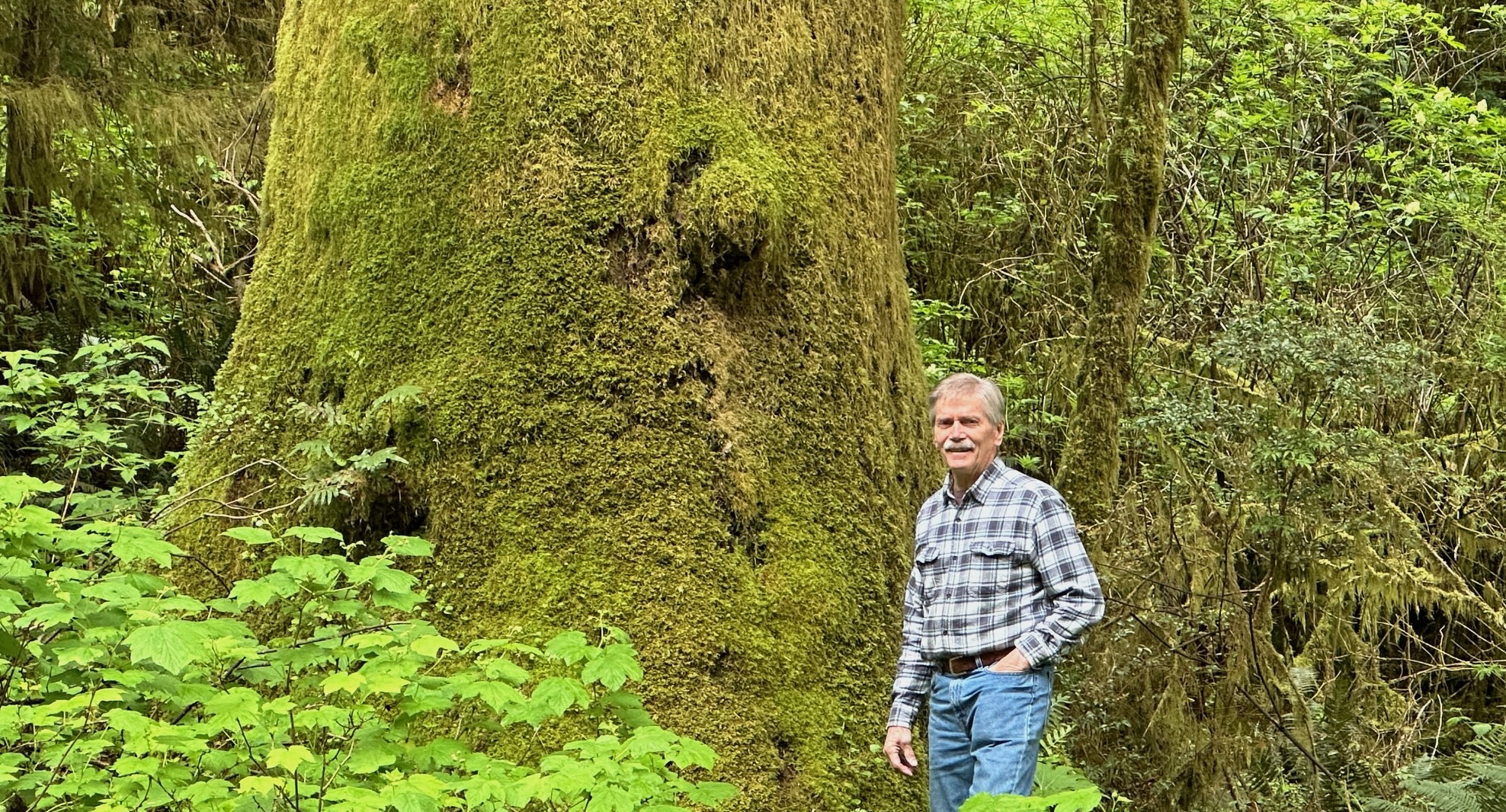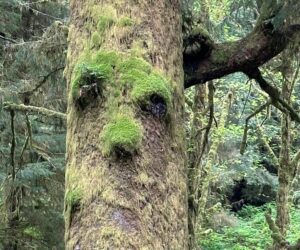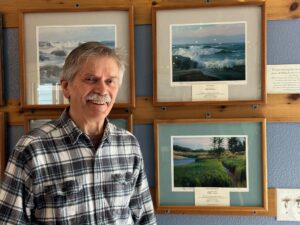
By KATHLEEN O’CONNOR/YachatsNews
Majestic. Mysterious. Magnificent. The old growth conifer trees on the central Oregon coast are treasures — huge cedars, spruce, fir, and hemlock trees that have been alive for literally centuries.
Phillip Schuster is a Yachats artist who has been drawing these trees since his first trip to the Oregon coast 40 years ago.
 Schuster grew up in Chicago and his first memory of art was when he was watching his mother paint when he was about 5.
Schuster grew up in Chicago and his first memory of art was when he was watching his mother paint when he was about 5.
“What are you doing?” he asked. “Painting,” she replied. “Why?” he asked. “Because it’s beautiful,” she said.
He started painting when he was about 10, after finding a set of his father’s old oil paints in the attic. He loved geography and for his final eighth-grade project he painted four African women, copying pictures from the family’s huge collection of National Geographic magazines. Schuster said he received an “F” because his teacher was certain one of his parents had painted the pictures. His father’s trip to the school got that corrected.
Schuster was drafted into the U.S. Army when he finished high school and sent to Vietnam. He was there for 19 months and discharged on April Fool’s Day 1970, which he finds ironic. He spent part of his time in Vietnam fighting and part of it as a guitar player in a USO band. The whole experience profoundly influenced his life, leading him to study war extensively and to reflect often on his fellow soldiers and the Vietnamese people. In 2015 he wrote a book about his time in Vietnam “The Wood of My Window.”
Schuster became an apprentice carpenter and over time enrolled in art classes in Chicago. Three or four instructors were pivotal in influencing the way Schuster’s art developed, but the most important was Charles Vickery, a well-known seascape artist. He studied privately under Vickery, and it was he who sent Schuster to Yachats to paint seascapes. Vickery had a cabin in Yachats which he let Schuster use for a vacation, and within a few years Schuster and his wife had purchased a house on Second Street, where he still lives.
Question: What draws you to trees?

Answer: Old trees have fought for so many years to survive. I admire their perseverance through all kinds of trauma. The first old tree I drew in Yachats is a spruce that is on the south-facing slope of Devils Churn, just 15 feet above the high tide mark. It is still there, barely alive, twisted, broken, living courageously. That particular tree carries symbolic meaning for me. It speaks to me of my mother and the courage she showed throughout life. I became even more interested in the ancient trees in the mid-1990s when there were many protests along the West Coast about logging old growth forests. I have continued to learn how important they are for our environment, delving particularly into studying the marbled murrelet.
Q : Why do you draw the trees instead of painting them?
A: The old growth trees are generally in rugged spots. I always draw them “en plein air” (in the open air), not from photographs. I usually have to tramp through weeds and brush to get to a good spot to create the drawing, so I keep things simple. I just carry my compact tripod easel, charcoal, a variety of pencils, a charcoal eraser and a daub. I keep everything in a particular order so it’s easy to set up.
Q: What kind of trees do you like the best?
A: Western cedar trees are my favorite because they are so expressive. They have fantastic side arms and huge tangles of branches. One cedar tree that I painted had a side arm that circled all the way around the tree like a belt, or maybe it was a halo at one time. They often form cathedral trees. If the main trunk of a tree is damaged several new trunks can sprout around it, growing up to create a lovely group of trees all encircling the old trunk.
Q: What the kind of person would purchases one of your tree drawings?
A: Unpredictable. Like me, many people are simply drawn to trees, but the reasons they give for buying them are various and sometimes quite humorous. One man told me that the drawing he purchased of a Sitka spruce was just like the trees in his home state of Nevada. There are no Sitka spruce trees in Nevada. Often artists say that people don’t buy paintings; they buy stories. I do tell people the stories of my trees, and perhaps that influences some of them.

Q: You had lived in Yachats quite a long time before you joined the Yachats Art Guild, which has a show this weekend. What have you enjoyed about being part of that group?
A: For a long time, I didn’t really have time to be part of the guild. I had a construction business in Yachats that took much of my time, and I helped to care for my son, Matthew, who had many health problems. I had more time after Matthew passed away in 2017 at age 27, and after I stopped building houses. The guild is a remarkable group. It is very organized, all the members are active, and they create a wonderful variety of art. I often buy something for my own house at our shows.
Tell us a secret:
Once I had a fabulous encounter with bats while I was out painting. I was looking for a spot to paint when I knocked a large piece of bark off a huge fallen Sitka spruce tree. At least 50 bats flew up in a cloud, and four or five of them paused right in front of me, hovering near my face. It was a magical, ethereal experience.
- To see Schuster’s works, go to his website here
- Kathleen O’Connor is a Waldport freelance writer who can be reached via email at kmoc8916@gmail.com



I get sick and tired as our state and federal governments allow the complete devastation of the forest in the Pacific Northwest. They continue to allow clear cutting which completely goes against our environment in so many ways. Salmon are nearly extinct, largely because of the water getting too warm and loss of habitat. When the land is clear of trees, the little feeder streams, many without names heat to the point that fish cannot survive. The landslides we all hear about the time are largely caused by complete clearing of hill sides allowing erosion, again which kills salmon based on the dirt and silt that fills the streams. People need to wake up to the fact that as we allow this continue all will be lost. They could selectively log and leave cover to protect all streams and keep the ground intact to not cause erosion. Another thing going on, which should not, is the fact we are sending seven train loads of over 100 cars a day through the Columbia River Gorge here in Oregon/Washington which gets loaded on huge ships near Kalama, Wash. bound for China and other countries which use it with little to no pollution control. We are supposed to all be so climate minded and this is going on??
That’s coal I’m refering to being shipped through the Columbia River Gorge daily.